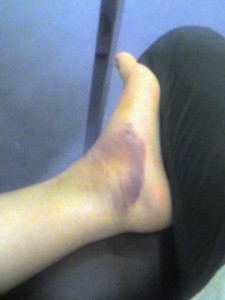The Moment You Sprain Your Ankle

We have all been there before. That moment where you are playing a sport or out running and you feel your ankle roll. Before you hit the ground your brain has been able to process that something went wrong. There are different kinds of ankle sprains out there and differing levels of severity. The most common ankle sprain is the lateral ankle sprain, and this is the injury that occurs when you roll your ankle. In most cases these can be treated conservatively at home and you shouldn’t have to miss too much time from the activities that you love. Some more severe sprains require treatment from a physical therapist to help speed the healing process along.
Treating A Sprained Ankle At Home
If you are going to treat an ankle sprain at home, the first thing to remember is PRICE. PRICE stands for Protection, Rest, Ice, Compression, Elevation. This helps with the acute (immediately after the injury occurs) phase of the injury by reducing the pain and swelling. Protection means limiting the amount of stress you are placing on the ankle right after the injury, this can mean wearing a boot or just limiting your amount of activities that cause pain. Rest is simply stopping activities that cause pain and allowing the ankle time to heal. Compression can be applied using an ACE wrap or other compressive wrap to help reduce swelling. The ice should be applied in 20 minute increments and can be applied in conjunction with the compression. Elevate the ankle above the level of your heart while using the ice and compression.
When To See A Physical Therapist
If you have tried PRICE and the ankle still remains painful, that is the time to see a physical therapist. With a more severe sprain, the muscles around the ankle that provide stability can be weakened along with impaired proprioception (the body’s ability to know where it is in space which helps with balance). After the acute phase of the injury, movement and strengthening exercises are a great way to help rehab the injury. 4-way ankle exercises using a Theraband are a great place to start, along with some single leg stance exercises. It’s important to build the strength and endurance back up in the muscles damaged following an ankle sprain, because it will decrease your pain and help prevent another ankle sprain from occurring. While these are great starting exercises you should speak with your physical therapist to progress the exercises and see what’s best for your injury. Your physical therapist may also provide some joint mobilizations to help restore mobility to the ankle which was lost during the injury.
About the author:
Dr. Kevin Prue PT, DPT, CSCS is a graduate of Duke University’s Doctor of Physical Therapy Program. He is the president and director of Prue Physical Therapy & Sports Performance located in Cary NC. He specializes sports and orthopedic physical therapy, sports performance training and injury prevention for youth and recreational athletes. 
 Appointments
Appointments We have all been there before. That moment where you are playing a sport or out running and you feel your ankle roll. Before you hit the ground your brain has been able to process that something went wrong. There are different kinds of ankle sprains out there and differing levels of severity. The most common ankle sprain is the lateral ankle sprain, and this is the injury that occurs when you roll your ankle. In most cases these can be treated conservatively at home and you shouldn’t have to miss too much time from the activities that you love. Some more severe sprains require treatment from a physical therapist to help speed the healing process along.
We have all been there before. That moment where you are playing a sport or out running and you feel your ankle roll. Before you hit the ground your brain has been able to process that something went wrong. There are different kinds of ankle sprains out there and differing levels of severity. The most common ankle sprain is the lateral ankle sprain, and this is the injury that occurs when you roll your ankle. In most cases these can be treated conservatively at home and you shouldn’t have to miss too much time from the activities that you love. Some more severe sprains require treatment from a physical therapist to help speed the healing process along.